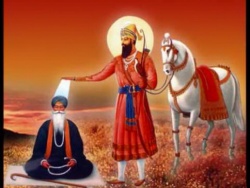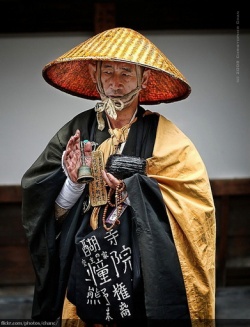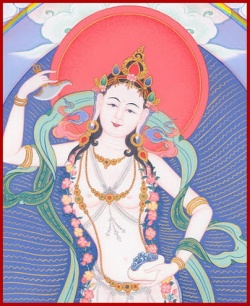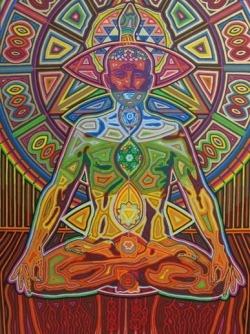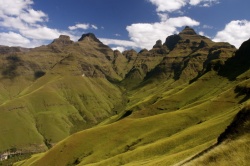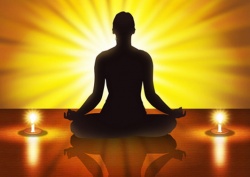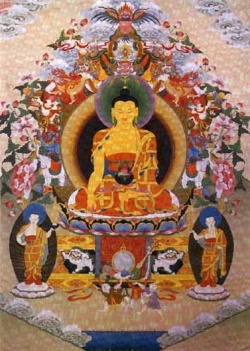The general Wind humor (rLung-spyi)
The general Wind humor (rLung-spyi)
The Wind humor is the breath, life force, and energy of the body/mind. It is pervasive and circulates inside and outside of the body. It manifests from the mind and the subtle wind energy and it is the source of respiration, movement, strength, and the power of the body/mind.
It especially governs the main function of the mind and the wind systems. During embryo development, it goes down to the perineum and moves upward to the head straight from the navel chakra through the central channel, piercing the five chakras like a tree and its root. It is called the ‘Wind humor’ and its most important branch is the life sustaining wind (srog’zingyi-rlung).
The Wind humor is concentrated in the central channel where the mental consciousness is active and the life fuel energy is deposited. This is the root and trunk of the Wind energy. The central channel has five chakras which are like the nodes of a tree while the organs and sensory organs are like the tree’s fruits and flowers.
The Wind humor has five principal winds and five minor winds which comprise the vital wind energy. They sustain life and manifest from the emotions of attachment and desire.
The Wind humor shares the same nature and characteristics as wind in general or air but the ‘human bodily wind’ is subtler and smoother. The Wind humor governs the central channel and its branches, and, along with the Bile and Phlegm humors, the central part of the body. It rules psychic functions and emotions and neutrally balances the other two humors.
There are three main sources for the Wind humor
1. The continuum subtle wind energy coming from the past life with the bardo consciousness is called the ‘mental affliction wind’ (nyonmongpai-yidkyi-rLung [I]) and it is the main cause of the Wind humor.
2. The wind energy received and developed from the wind element of the parents and especially from the mother during fetus development becomes the physical [[Wind] humor]].
3. The Wind energy is also received throughout life from the food and air which support the Wind humor system.
The Wind humor’s location and general functions
The Wind humor is found in every part of the body but it is particularly active in the heart, lungs, colon, small intestine, skin, ears, bones, hip joints, joints, lumbar-sacral area, lower abdomen and nervous system.
Tibetan Medicine and Yoga tantra describe five main wind branches of the general Wind humor. They are also called the principal or root winds and they are mainly located in the five chakras of the five body parts, from where they govern the psychic and body functions.
The five chakras are:
the crown chakra,
throat chakra,
heart chakra,
navel chakra and
secret chakras.
In short they are the cause, governor, and sustainer of the five emotions and psychic energies.
Functionally, the Wind humor is a cold but neutral energy and it is equally able to associate itself with Phlegm or Bile.
Wind serves as the vehicle of the mind and enables the mind to perceive sensations and thought. Wind regulates respiration and mobility, and sustains life through breathing; it gives energy for movement, and makes blood, lymph and subtle energy circulate. Wind helps absorb nutrition, transform tissues, clear the sensory organs, and sustain their functions.
It controls the senses, as well as the functions of the vital and hollow organs. It transfers memory and experience of the gross mind to the subtle mind. In short: all the physical and mental functions depend on the Wind humor. Wind gives life to the body as well as to the body’s microorganisms. Wind transports the consciousness, lightens awareness and gives power to the mind.
The six characters of the Wind humor
The Wind humor has six qualities or characters:
These six qualities maintain the body in a general way by balancing the other two humors. Wind keeps Bile and Phlegm in balance and equilibrium by neutralizing the opposite elements.
But when the Wind itself becomes too strong, it attacks the other two humors, takes power from them and creates an imbalance. Then the body begins to show the Wind symptoms of dryness (coarseness), physical and mental lightness and restlessness, as well as sensitivity to cold. The mind becomes more fragile and subtler (sensitive), while the wind’s quality of hardness manifests lump, abscesses, tumors and swellings, and the body/mind’s nature becomes unstable.
Wind has a neutral nature and it is able to associate itself with the other two humors: Wind helps increase the Bile fever but also cools down the Phlegm humor. However, Wind itself has a cold nature and dry nature.
The types of Wind humor (rLunggi-rigs)
Wind is found in all parts of the body and in all cells and particles. All winds in short belong to the five principal and five minor winds. They functions in the head, throat, chest, abdomen, lower abdominal and in the back of the body and in the coccyx area.
The five principal winds govern and help manifest the five gross emotions of;
ignorance,
attachment,
anger,
pride, and
jealousy respectively from the five chakras:
crown,
throat,
heart,
navel and
secret chakra.
The five chakras or body divisions are like the five provinces of a state where the principal winds are the governor. The five minor winds rule the five sensory faculties and they derive from the principal winds. There are many other different types of winds which manifest from the principal winds, and each wind is responsible for a different emotion. Winds and emotions manifest through the function of the body channels of the five chakras. The Buddhist sutras describe 84.000 emotions while the Mother Tantra counts 72.000 emotions [II].
The five principal Wind branches (rTsawei-rlung-lna)
The five principal Winds function separately in five different body locations or chakras, under the general command of rLung/wind humor.
They all manifest from the Life sustaining Wind (Srog’zingyi-rlung) of the central channel during the fetus development, like rays emerging from the sun.
They are:
No Wind Chakras and body parts Negative emotions
([[Srog-‘zin-rlung) Head and crown chakra Ignorance
(rGyen-rgyui-rlung) Upper body and throat chakra Attachment
(Khyab-byed-rlung) Chest and heart chakra Anger Anger
(Memnyam-rlung) Abdomen and navel chakra Pride and greed
(Thursel-rlung) Lower abdomen and secret chakra Fear and jealousy
[I] This wind manifests from attachment, and remains with the mind and produces all the mental affliction thoughts. [II] More details can be found in the Abhidharma and Buddhist tantras.
Source
http://www.tibetanmedicine-edu.org/index.php/n-articles/the-three-humors-part-3
